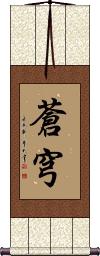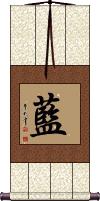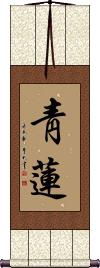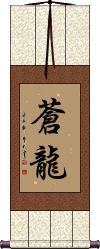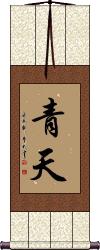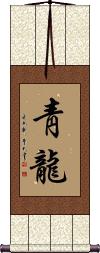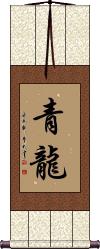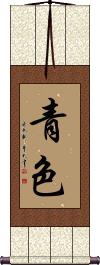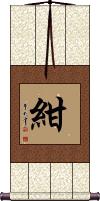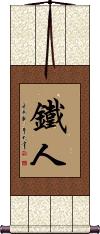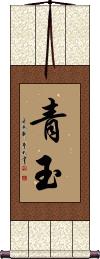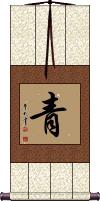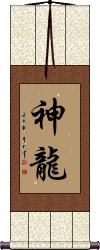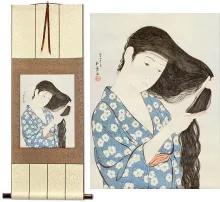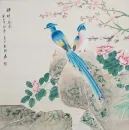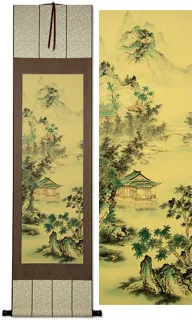Many custom options...
And formats...

Blue Sky in Chinese / Japanese...
Buy a Blue Sky calligraphy wall scroll here!
Personalize your custom “Blue Sky” project by clicking the button next to your favorite “Blue Sky” title below...
1. Blue Sky
3. Blue Lotus
4. Blue Dragon
8. Cyan
9. Violet Color
11. Sapphire
13. Sapphire
14. Shichi-Kyu
15. Chung Do Kwan
16. Green
17. Shen Long
Blue Sky
The Blue Dome of Heaven
Blue / Indigo
Color
藍 is the single character for the color blue in Chinese.
It can also mean indigo in Japanese Kanji and old Korean Hanja.
Blue Lotus
靑蓮 is a common title for Blue Lotus.
靑蓮 is often used in a Buddhist context for blue lotus from the Sanskrit “utpala.” This often refers to the clarity and purity of the lotus blue eyes possessed by a Living Buddha. It can also represent the purity of mind (without desire, suffering, fear, etc.).
Blue Dragon
Clear Blue Sky
Green Dragon / Blue Dragon
靑龍 is a title that can mean blue or green dragon.
The first character can mean blue, green, azure, or celadon.
The second character means dragon.
This is mostly a Chinese title (especially in Buddhism). It will be understood but less commonly used in Japanese and Korean.
Blue Dragon / Azure Dragon
青龍 is a scholarly title for “Blue Dragon” or “Azure Dragon.”
You'll find this title used in ancient Chinese literature and astronomy. This dragon has dominion over the eastern sky or eastern heavens. The Azure Dragon is also noted for representing the spring season. Also seen as an auspicious omen.
Emperor Huizong of the Song Dynasty canonized the five colored dragons as “kings.” The Azure Dragon represents the most compassionate of kings.
In Japanese, this title is known with the same meaning but can also be a given name, Seiryuu or Seiryu.
Note, the first character can be written as ![]() OR
OR ![]() . Same character, just two ways to write it.
. Same character, just two ways to write it.
Cyan
Violet Color
紺 is a slightly-rare Chinese and old Korean title for the color violet or purple.
In Japanese, this refers to a very deep blue color.
Ironman Triathlon Event
Sapphire
Ch'ang Hon Taekwondo
蒼軒跆拳道 is the title “Chang Hon Taekwon-Do” written in old Korean Hanja.
This literally means “Pale Blue Kick Fist/Punch Way.”
The rather awkward official romanization is “cang heon tae gweon do.”
Occasionally, you will see the first Hanja character written as 苍 instead of 蒼. it’s just a different way to write the same character. If you want 苍 instead of 蒼, just let me know.
Sapphire
Shichi-Kyu
七級 or Shichi-Kyu/Shichikyu is the 7th Kyu or 7th Rank before black belt in many Japanese martial arts ranking schemes.
In some cases this is a yellow belt with two stripes, other schools designate this with a blue belt.
In Chinese, this can mean seven floors - like a seven-floor pagoda.
Chung Do Kwan
靑濤館 is the Korean martial arts style, Chung Do Kwan, meaning “Blue Wave School.”
If you want this in modern Korean Hangul characters, click on the Hangul next to the Korean flag above instead of the button above.
Also Romanized as “Cheong Do Gwan” or “Ch'ŏng Do Kwan.”
Green
The fresh green of nature
青 is nature's color and can refer to forest green, greenish-blue, or the darkest of greens.
青 and color represent nature, youth, and young people.
In the same way, we refer to green bananas and the rookie being green, the same is true in Chinese and Japanese, where, in a certain context, this can mean immature, unripe, or young.
In Japan, this can also be a female given name “Haru.” It can also be used as a given name (for either sex) in China.
Shen Long
神龍 or Shen Long literally means “god dragon” or “divine dragon.”
神龍 is a spiritual dragon from Chinese mythology that controls wind, storms, clouds, and rain. Historically, farmers in China avoid offending this dragon, as it could result in a drought or flooding of their fields.
Shen Long has blue/azure scales and appears on the beautiful robes of some Chinese emperors.
Sometimes romanized as Shen Lung and sometimes written as 神竜 in Japan with the pronunciation of Shinryū or Shenron. It can also be a given name in Japan.
This in-stock artwork might be what you are looking for, and ships right away...
Gallery Price: $108.00
Your Price: $59.88
Gallery Price: $72.00
Your Price: $39.88
Gallery Price: $72.00
Your Price: $39.88
Beautiful Blue and Gold Chinese Birds & Flowers Painting
Discounted Blemished
Gallery Price: $71.00
Your Price: $39.00
Gallery Price: $268.00
Your Price: $148.88
Gallery Price: $101.00
Your Price: $55.88
Gallery Price: $50.00
Your Price: $29.88
Gallery Price: $63.00
Your Price: $34.88
Gallery Price: $63.00
Your Price: $34.88
Gallery Price: $72.00
Your Price: $39.88
Gallery Price: $83.00
Your Price: $45.88
Gallery Price: $60.00
Your Price: $36.88
Gallery Price: $72.00
Your Price: $39.88
Gallery Price: $63.00
Your Price: $34.88
The following table may be helpful for those studying Chinese or Japanese...
| Title | Characters | Romaji (Romanized Japanese) | Various forms of Romanized Chinese | |
| Blue Sky | 蒼穹 苍穹 | sou kyuu / soukyuu / so kyu | cāng qióng cang1 qiong2 cang qiong cangqiong | ts`ang ch`iung tsangchiung tsang chiung |
| Blue Indigo | 藍 蓝 | ai | lán / lan2 / lan | |
| Blue Lotus | 靑蓮 靑莲 | seiren | qing lián / qing lian2 / qing lian / qinglian | ch`ing lien / chinglien / ching lien |
| Blue Dragon | 蒼龍 苍龙 | cāng lóng cang1 long2 cang long canglong | ts`ang lung tsanglung tsang lung |
|
| Clear Blue Sky | 青天 | seiten | qīng tiān qing1 tian1 qing tian qingtian | ch`ing t`ien chingtien ching tien |
| Green Dragon Blue Dragon | 靑龍 靑龙 | sei ryū / seiryū | qīng lóng qing1 long2 qing long qinglong | ch`ing lung chinglung ching lung |
| Blue Dragon Azure Dragon | 青龍 / 靑龍 青龙 | sei ryuu / seiryuu / sei ryu | qīng lóng qing1 long2 qing long qinglong | ch`ing lung chinglung ching lung |
| Cyan | 青色 | aoiro | qīng sè / qing1 se4 / qing se / qingse | ch`ing se / chingse / ching se |
| Violet Color | 紺 绀 | kon | gàn / gan4 / gan | kan |
| Ironman Triathlon Event | 鐵人 铁人 | tetsu jin / tetsujin | tiě rén / tie3 ren2 / tie ren / tieren | t`ieh jen / tiehjen / tieh jen |
| Sapphire | 青玉 | seigyoku | qīng yù / qing1 yu4 / qing yu / qingyu | ch`ing yü / chingyü / ching yü |
| Ch'ang Hon Taekwondo | 蒼軒跆拳道 苍轩跆拳道 | |||
| Sapphire | 藍寶石 蓝宝石 | lán bǎo shí lan2 bao3 shi2 lan bao shi lanbaoshi | lan pao shih lanpaoshih |
|
| Shichi-Kyu | 七級 七级 | shichi kyu / shichikyu | qī jí / qi1 ji2 / qi ji / qiji | ch`i chi / chichi / chi chi |
| Chung Do Kwan | 靑濤館 | qīng tāo quǎn qing1 tao1 quan3 qing tao quan qingtaoquan | ch`ing t`ao ch`üan chingtaochüan ching tao chüan |
|
| Green | 青 | ao | qīng / qing1 / qing | ch`ing / ching |
| Shen Long | 神龍 | shenron / shinryuu shenron / shinryu | shén lóng shen2 long2 shen long shenlong | shen lung shenlung |
| In some entries above you will see that characters have different versions above and below a line. In these cases, the characters above the line are Traditional Chinese, while the ones below are Simplified Chinese. | ||||
Successful Chinese Character and Japanese Kanji calligraphy searches within the last few hours...
